How To Choose & Use a Vehicle Jack

Whether you get a flat tire on the road or you want to perform basic car maintenance in your shop, knowing the proper way to jack up a vehicle is vital. This procedure must be done correctly to prevent further damage, injury, or even death. In this guide, we will discuss the different types of jacks and the proper procedure for jacking up your vehicle to avoid catastrophe.
Understanding Your Vehicle Jack
Before discussing specifics, it is important to identify the type of vehicle jack you have. Each type of jack has distinct advantages and disadvantages that influence their use. Regardless of which jack you choose, always consider the weight capacity of the jack in comparison to the weight of the vehicle.
Floor & Trolly Jacks
Floor and trolley jacks are hydraulic jacks operated by a lever mechanism. Although heavier than other types of jacks, their castor wheels provide better mobility. They come in a variety of shapes and sizes to accommodate different vehicle types and are very easy to use, making them a popular choice.
While they're very similar, there are differences between trolley and floor jacks. Trolley jacks tend to be smaller and lift vehicles lower, making them suitable for roadside repairs. Floor jacks, on the other hand, are larger and provide a higher lift, making them used in professional settings more often.
Shop all Floor and Trolly Jacks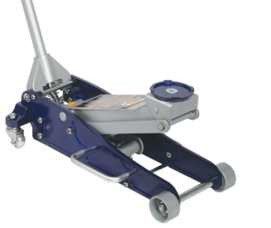
Scissor Jacks
Scissor jacks are mechanical jacks that use two sets of vertical arms contracted by turning a screw. Their simplicity requires minimal maintenance, and the lack of hydraulic components eliminates the risk of leaks. Their compact size allows easy storage in the boot of a car.
Shop all Scissor Jacks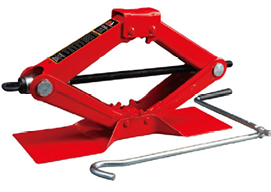
Bottle Jacks
Bottle jacks, another type of hydraulic jack, operate by forcing pressure from a small-diameter piston to a larger piston chamber when pumped. They are user-friendly and compact for easy storage. However, they typically have a lower weight limit and can be more unstable compared to other jacks.
Shop all Bottle Jacks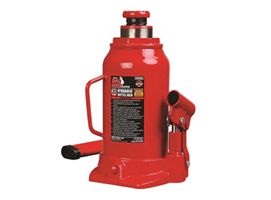
Air Jacks
Air jacks, also known as inflatable jacks, are operated by filling them with air, water or oil. They are extremely quick and require minimal space, making them suitable for confined areas that other jacks may struggle with.
Shop all Air Jacks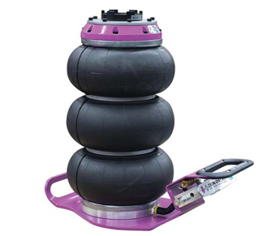
Specialty Jacks

Transmission jacks are designed to lift and lower a vehicle’s transmission from below, featuring a large cradle for easy installation, maintenance or replacement.
Shop Transmission JacksHow to Jack Up a Vehicle
Step 1.
The first step is to ensure you have all necessary equipment ready. A jack and jack stands are essential, but wheel chocks and lifting pads are also important to have on hand. Wheel chocks help secure your vehicle, while lifting pads can prevent damage. Additionally, verify that all equipment is in good working order and that you know the proper weight limits. Do not use a jack or jack stands that cannot handle the weight of your vehicle.
Step 2.
Next, create a safe environment. Ensure that you are on level ground and have a stable surface to prevent the vehicle from moving. Block the wheels with wheel chocks in front of each wheel opposite from the end of the car you will be lifting for additional safety. Then make sure the vehicle is in park and the parking brake is engaged.
Step 3.
Arguably, the most important step in lifting the car is deciding where to jack it up. The right location allows safer access underneath the vehicle and prevents damage. When you find a spot, ensure it is not rusted or damaged. There are various locations on a car that can be used to jack the vehicle up, which differ depending on the make and model. Check your owner’s manual for guidance. If that isn’t available, focus on finding a spot on the frame near the wheel that balances the vehicle to prevent tipping. These lifting areas are reinforced to handle the weight of your vehicle. Check your owner's manual or our towing instructions for guidance.
Once you have positioned the jack, the next step is simple: begin to jack your vehicle. Operate the machinery properly to avoid damage or unnecessary risk. 
To further avoid damage, place a lifting pad or block of wood between the jack and the car to spread out the load. This does not work with all jacks, but floor jacks, bottle jacks and scissor jacks can benefit from them. While you can start out jacking a bit faster, slow down as the jack makes contact with the vehicle. Raise the vehicle a little higher than you need, but not so high that it risks tipping over.
Step 4.
Once you’ve lifted the vehicle just above where you need it, place jack stands under the appropriate locations, close to where the jack is positioned as they will hold the vehicle's weight. Adjust the jack stands to the proper height, and slowly lower the jack until the vehicle rests on the stands. Ensure your jack stands can handle the vehicle’s weight.
If you plan on lifting all wheels, lift the vehicle one end at a time. For example, if you lift the front left tire first, lift the right front tire next. This helps keep the vehicle stable.
Once the vehicle is properly lifted, perform a final check to catch any issues before working underneath. Verify that the vehicle is level and all stands are at the same height to ensure they do not slip. Then, gently push the vehicle to ensure it is stable.
When the work is done, re-lift the vehicle using your jack until the weight is off the jack stands. Remove the stands and slowly lower the vehicle back down. The vehicle's shocks will absorb the descent, so don’t worry if it seems too quick. You can then remove the jack. If you lifted all wheels, follow the same pattern you used when raising them.
Conclusion
Knowing how to lift your vehicle and choosing the appropriate jack can prevent excessive damage and ensure your safety. Whether you are dealing with a flat tire on the side of the road or performing routine maintenance in your shop, this guide aims to help you lift your vehicle correctly and safely. For all your jacking needs and more, explore our Auto & Truck Service section at zips.com



%20blog%20thumbnail.png)
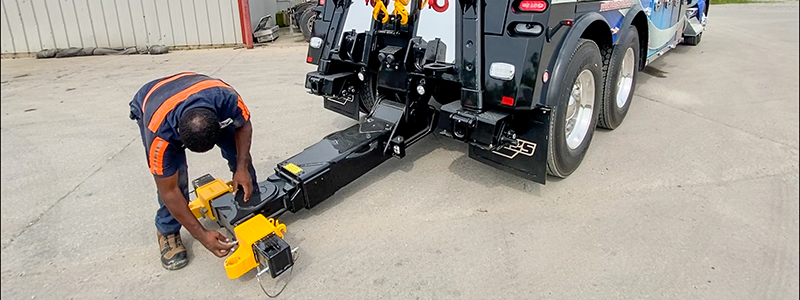

%20blog%20thumbnail.png)







